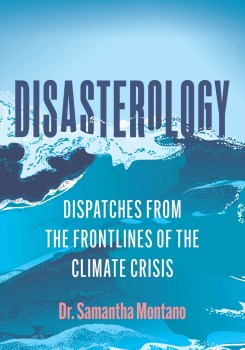To Plan For Disaster, Talk To Your Community
With climate change accelerating, a disaster researcher offers tips on what government agencies can do better when planning for emergencies.
The following is an excerpt from Disasterology: Dispatches from the Frontlines of the Climate Crisis by Samantha Montano.

Disasterology: Dispatches from the Frontlines of the Climate Crisis
One of the only pop culture depictions of a local emergency manager is Tommy Lee Jones in Volcano (1997). His character is portrayed as a one-man, lava-diverting hero who has the primary decision-making authority for the county of Los Angeles. His character represents what most emergency managers probably wish they did, but it is far from reality. It is actually Don Cheadle’s character, the deputy emergency manager, that is a much more accurate, albeit less exciting, depiction of the job. While Jones is climbing through downtown LA sewers, Cheadle is in the city’s emergency operations center fielding calls, directing resources from various agencies, and filling out paperwork. Although it’s not the world’s most glamorous job, emergency management officials play a critical role in disaster response. They also play a critical role in preparedness and mitigation long before disaster strikes and in the recovery afterward. This isn’t an easy job and it can be made more difficult when emergency managers aren’t given the resources they need.
The problems that permeate FEMA at the federal level are often replicated at the state and local levels. Despite knowing that investment in mitigation and preparedness pays off, emergency management agencies across the country are perpetually underfunded, particularly in rural and poor communities that are unable to dedicate the resources to the work that most know need to be done.
Local emergency managers often have very little power. Legally, the authority for decision making tends to fall to the mayor or other elected officials. Further, rather than being stand-alone agencies, many local emergency management offices are located within police and fire departments where they have to navigate a hierarchy of people in order to even talk to decision makers. Even more problematic is the fact that their position within these departments leads to an emphasis on response, rather than comprehensive emergency management that factors in mitigation and recovery.
In the summer of 2020 during the height of the protests over the brutal murder of George Floyd by a Minneapolis police officer, Los Angeles mayor Eric Garcetti released the 2020-2021 city budget. There was widespread outrage as the proposal showed $3.14 billion earmarked for police. In comparison $6 million was earmarked for emergency management. Tommy Lee Jones and Don Cheadle are going to need more than that to save LA.
Some emergency management agencies in big cities are more robust. New York City Emergency Management has over two hundred employees and a $40 million budget, but that is not the reality for most emergency management agencies across the country. Many rural communities and small towns have only a part-time or volunteer emergency manager. Smaller communities that do not have the budget or need for big agencies often rely more heavily on county agencies. Given the lack of resources and support, local emergency managers are limited in what they can do to prepare their agencies and their communities for disaster (let alone work on mitigation and recovery).
Planning is one obvious starting point for helping us be more prepared. Yet, even this relatively simple task can be a struggle for some agencies. Response plans, like those produced by BP, are completely inadequate. Although the plan quality varies, most if not all communities have some type of response plan. They might not have been updated recently and may just be sitting on a shelf, but they are something. It’s not enough, though, to make a plan to be able to check a box and say you did. When this happens (and it happens more often than we would like to think), it creates huge problems. Planning is a continual process, not something that can just be done once. Having a dusty plan sitting on a shelf does not make anyone safer.
If a plan is to be effective, the planning process cannot be done by an emergency manager sitting alone in their office. It has to include everyone who is a part of the plan—or as FEMA puts it, “the whole community.” Research has consistently shown that the most important part of planning is the process, rather than the plan itself. In other words, it is various community stakeholders coming together in the same room to talk about what could go wrong, how they will respond, and who will be responsible. The process itself is what makes planning worth doing, and filling out a “cookie cutter plan” downloaded from the internet—or copy and pasted from your Arctic plans—isn’t enough.
It’s also not enough to just have response plans. We also need to prepare for recovery. Recovery planning rarely happens, despite research that suggests planning for recovery can make the process more effective and efficient. Communities often arrive in recovery exhausted from the response. They end up playing “catch-up” for years, which sets the community up for a difficult recovery process like I saw in New Orleans and other communities around the country. These long recoveries can create divisions in the community, hinder the implementation of mitigation efforts, and leave the community vulnerable to outside interests.
Excerpted from Disasterology © 2021 by Samantha Montano, used with permission by Park Row Books.
Samantha Montano is an assistant professor of Emergency Management at the Massachusetts Maritime Academy and author of Disasterology: Dispatches from the Frontlines of the Climate Crisis (Park Row, 2021). She’s based in Buzzards Bay, Massachusetts.